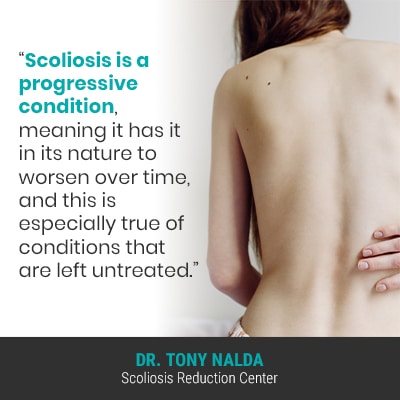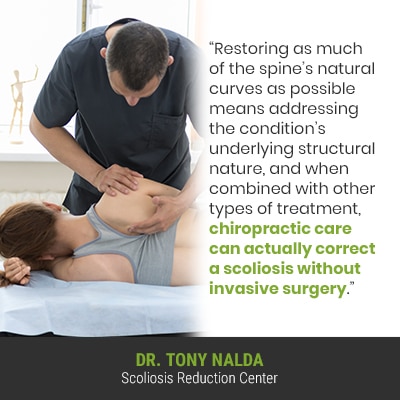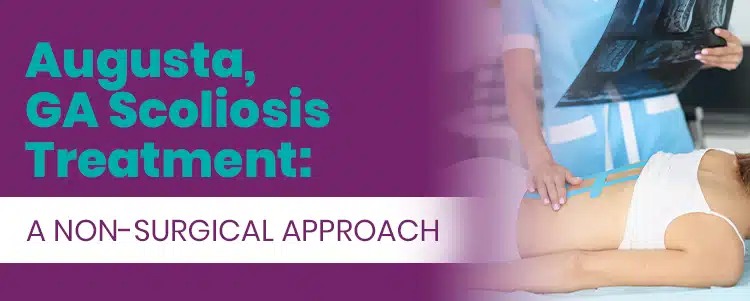It’s important for patients to be informed on the different scoliosis treatment approaches available because choosing the type of treatment to commit to can have far-reaching effects. Continue reading to find out what a modern conservative non-surgical scoliosis treatment approach can achieve.
There are two main scoliosis treatment approaches. For residents of Augusta, Georgia, Dr. Tony Nalda, one of the world’s leading non-surgical scoliosis specialists, is just over a 3-hour flight, or a 6.5-hour drive away, at Celebration, Florida’s Scoliosis Reduction Center®.
As current estimates put close to seven million people living with scoliosis in the United States alone, let’s start with how the condition is diagnosed, before moving onto the specifics of treatment.
How is Scoliosis Diagnosed?
Scoliosis is diagnosed when a person develops an unnatural spinal curvature that bends to the side, and twists from front to back, back to front, making it a complex 3-dimensional condition.
Diagnosing scoliosis involves a comprehensive physical examination that involves observing a patient’s posture and gait, often performing an Adam’s forward bend test to look for condition indicators, and taking the patient’s medical history, with a focus on spinal conditions that run in the family.
If the physical exam indicates scoliosis, I order an X-ray to see exactly what’s happening in and around the spine, and to measure a patient’s Cobb angle.
Another parameter that has to be met in order to reach a diagnosis of scoliosis is a minimum Cobb angle of 10 degrees.
A patient’s Cobb angle measures the most-tilted vertebrae at the curve’s apex, tells me how far out of alignment a scoliotic spine is, and classifies conditions in terms of severity:
- Mild scoliosis: Cobb angle measurement of between 10 and 25 degrees
- Moderate scoliosis: Cobb angle measurement of between 25 and 40 degrees
- Severe scoliosis: Cobb angle measurement of 40+ degrees
- Very-severe scoliosis: Cobb angle measurement of 80+ degrees
The higher the Cobb angle, the more severe the condition, and the more likely it is that its effects are going to be noticeable.
In addition to condition severity, scoliosis is further classified based on other key patient and condition variables: patient age, condition type (cause), and curvature location.
As you can see from the wide range of Cobb angle measurements, and the condition’s highly-variable classification points, no two cases are the same, which is why the complex nature of scoliosis necessitates a customized treatment approach designed by a specialist.
So for those recently diagnosed, what’s the next step?
Scoliosis Treatment Options: Surgical vs Non-Surgical
As mentioned, whether scoliosis is treated surgically or non-surgically is a big decision because these different approaches offer patients very different potential outcomes.
For those on the path of traditional scoliosis treatment, patients are commonly funneled towards spinal fusion surgery, with the end goal of stopping progression.

Scoliosis is a progressive condition, meaning it has it in its nature to worsen over time, and this is especially true of conditions that are left untreated.
Traditional Scoliosis Treatment
Traditional scoliosis treatment was the dominant choice for many years, but that doesn’t mean it was the best, nor the only option available.
Traditional scoliosis treatment focuses solely on stopping progression, which is different from working towards correcting a scoliosis.
Traditional treatment doesn’t actually have a strategy for treating scoliosis while mild, so watches and waits until a patient’s condition progresses into the severe level, at which point they become surgical candidates.
But other than traditional bracing, associated with a number of shortcomings, no form of treatment is applied in an effort to prevent progression; this is why traditional treatment is commonly described as more reactive than proactive.
Once a surgical recommendation is given, patients have an important decision to make.
While spinal fusion surgery, when successful, can straighten a scoliotic spine, it does so through invasive means that involves fusing the curve’s most-tilted vertebrae together into one solid bone, removing intervertebral discs between vertebrae being fused, and commonly attaching rods to the spine with screws.
A fused spine is permanent, as is any hardware attached, and the fused section of the spine will be rigid, and this is often the main surgical outcome that disappoints patients; there can be a significant loss in spinal flexibility and range of motion that can impact quality of life.
In addition, a spine that’s fused is not as strong, making it more vulnerable to injury.
So while surgical treatment is an option for severe scoliosis, the reality is that most cases of scoliosis can be treated non-surgically, especially those that are addressed proactively before
Conservative Scoliosis Treatment
For those looking for Augusta scoliosis treatment, from Augusta, Georgia to Celebration, Florida is 417.5 miles, so by car or plane, world-class scoliosis chiropractor, Dr. Tony Nalda, is reachable within a day’s travel time.
The Scoliosis Reduction Center® has been helping thousands of patients thrive, despite being diagnosed with a progressive spinal condition, by treating their scoliosis proactively.
Here at the Center, I start treatment as close to the time of diagnosis as possible.
While there are no treatment guarantees, early detection, when responded to with proactive treatment, increases the likelihood of treatment success, and while managing progression is a focus of conservative treatment, the end goal is more about correction.
Correcting a scoliosis means reducing the unnatural spinal curve on a structural level, and this is worked towards through condition-specific chiropractic care involving a series of techniques and manual adjustments that can realign the spine.

Restoring as much of the spine’s natural curves as possible means addressing the condition’s underlying structural nature, and when combined with other types of treatment, chiropractic care can actually correct a scoliosis without invasive surgery.
Physical therapy is a key facet of treatment as it can work towards strengthening the spine’s surrounding muscles so it’s optimally supported, addressing any related muscle imbalance, and improving posture.
Corrective bracing and rehabilitation can help augment corrective treatment results by pushing the spine into a corrective position, and further stabilizing the spine through a series of custom-prescribed scoliosis-specific exercises and stretches for patients to establish a home-rehabilitation program.
Conclusion
Those in search of non-surgical scoliosis treatment travel from around the country, and world, to benefit from what the Scoliosis Reduction Center® has to offer, and residents of Augusta, GA are fortunate to be within 420 miles of the world-class scoliosis treatment center and Dr.Tony Nalda.
From his early days in the medical industry, Dr. Tony knew that scoliosis treatment was where he wanted to focus his time and energy.
Through spreading awareness, Dr. Tony has helped rewrite the narrative around a potentially-confusing condition, and his non-surgical treatment results speak for themselves.
Reach out to us here to find out how you can benefit from a proactive treatment plan that’s helped thousands avoid the potential complications and side effects of surgical treatment.




